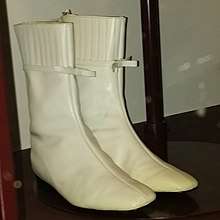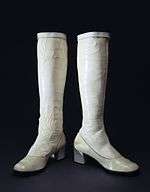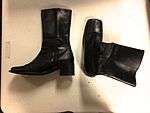Go-go boot
Go-go boots are a low-heeled style of women's fashion boot first introduced in the mid-1960s. The original go-go boots, as defined by André Courrèges in 1964, were white, low-heeled, and mid-calf in height,[2] a specific style which is sometimes called the Courrèges boot.[3][4] Since then, the term go-go boot has come to include the knee-high, square-toed boots with block heels that were very popular in the 1960s and 1970s; as well as a number of variations including kitten heeled versions and colours other than white.[5][6]


Etymology
The term go-go is derived from the French expression à gogo, meaning "in abundance, galore",[7] which is in turn derived from the ancient French word la gogue for "joy, happiness".[8] The term "go-go" has also been explained as a 1964 back-formation of the 1962 slang term "go", meaning something that was "all the rage"; the term "go-go dancer" first appeared in print in 1965.[9] The go-go boot is presumed to have been named after the dance style.[5][10]
1960s
Fashion boots were revived in the early 1960s by designers such as Beth Levine, although at first they featured fashionable high heels such as the stiletto and kitten heels.[11] The earliest go-go boots were mid-calf, white and flat-heeled, as seen in the work of the designer André Courrèges, who is often credited with creating the style.[10][12] The simple minimalism of the Courrèges boot was easily and widely reproduced for the mass market.[1][4] Courrèges boots provided the foundation for the development of the go-go boot, which increasingly came higher up the leg and was made in alternative colours.[5][12] While remaining low-ish, the heel also became higher and chunkier.[5] The earliest Courrèges boots were made of leather, such as kidskin or patent leather,[4] but many of the subsequent versions and copies were made in PVC, vinyl, and other plastics.[10]
_Istanbul_to_London_3-70_March_1970_00399_(32759055117).jpg)
In 1966, the song "These Boots Are Made for Walkin'" was released and performed by a go-go boot wearing Nancy Sinatra, who is credited with further popularising the boot.[12] Tim Gunn suggests that Sinatra helped establish the boot as "a symbol of female power".[13] Female dancers on the television shows Hullabaloo and Shindig! also wore the short, white boots.[14] This led to the boots sometimes being called 'hullabaloo boots,' as in an advertisement run in American newspapers in January 1966 for hullabaloo boots with "kooky heels and zipper backs" for the "Go-Go Getter".[15]
Post-1960s

In the mid-1990s, as part of a general revival of 1960s fashions, go-go boots came back into style.[16]
References
- "Pair of boots by André Courrèges, 1965". Search The Collections. V&A Museum. Retrieved 17 March 2015.
- O'Keeffe, Linda (2014). "The Shoe that left an Imprint: The Go-Go Boot". Shoes: A Celebration of Pumps, Sandals, Slippers & More. Workman Publishing. pp. 338–339. ISBN 0761173439.
- Cumming, Valerie; Cunnington, C.W.; Cunnington, P.E. (2010). The dictionary of fashion history. Oxford: Berg. p. 108. ISBN 9781847887382.
- O'Hara, Georgina (1986). The encyclopaedia of fashion. New York: H.N. Abrams. p. 79. ISBN 9780810908826.
- Stalder, Erika (2008). Fashion 101: a crash course in clothing. San Francisco, CA: Zest Books. p. 89. ISBN 9780547946931.
- Bleikorn, Samantha (2002). The Mini-Mod Sixties Book. San Francisco, CA: Last Gasp. p. 78. ISBN 9780867196429.
- "gogo". Merriam-Webster. 2007-04-25. Retrieved 2009-12-06.
- Le Petit Robert: GOGO (À), 1440; de l'a. fr. gogue "réjouissance"
- "''Online Etymology Dictionary'': go-go". Etymonline.com. Retrieved 2009-12-06.
- Pedersen, Stephanie (2005). Shoes : what every woman should know. Newton Abbot: David and Charles. ISBN 9780715322345.
- "Beth Levine. Evening boot, c.1962". The Collection Online. Metropolitan Museum of Art. Retrieved 29 January 2015.
- "Solemates: A Century in Shoes: 1960". Centuryinshoes.com. Retrieved 2015-01-29.
- Gunn, Tim; Calhoun, Ada (2012). Tim Gunn's fashion bible : the fascinating history of everything in your closet (1st Gallery Books hardcover ed.). New York: Gallery Books. p. 199. ISBN 9781451643862.
- Douglas, Susan J. (2010). "Why the Shirelles Mattered". In Forman-Brunell, Miriam; Paris, Leslie (eds.). The Girls' History and Culture Reader. ; The Twentieth Century. Urbana: University of Illinois Press. ISBN 9780252077685.
- "Marshmallow Leather-Like Hullabaloo Boots". Reading Eagle. 18 January 1966. Retrieved 29 January 2015.
- "Fashions: Year In Review 1995". Retrieved March 17, 2015.
External links
![]()